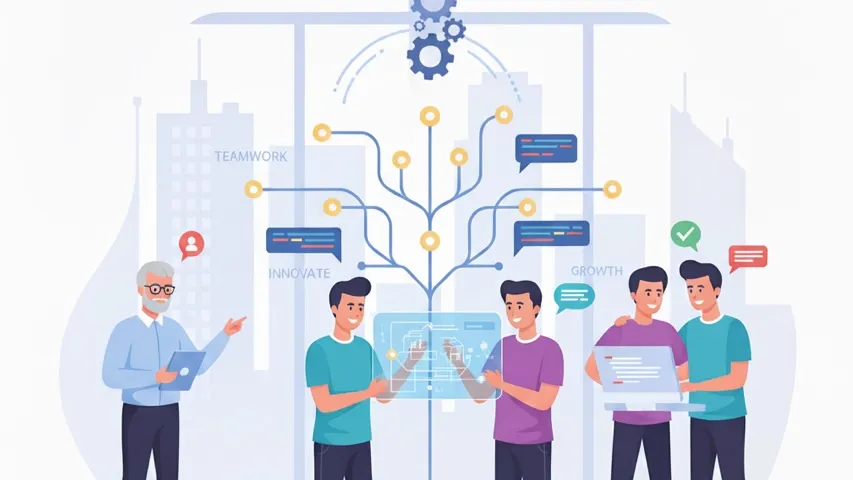Leading Growth: How Engineers and Teams Thrive Together

Strong engineering teams grow in two dimensions: individual technical mastery and collective team dynamics.
While personal growth depends on each engineer’s initiative, it accelerates when guided by experienced leads.
At the same time, healthy team dynamics don’t emerge by chance—they must be modeled, nurtured, and reinforced by leadership.
Guiding Personal Technical Growth in a Team
Each engineer should be the lead of their own growth. But growth accelerates when a more experienced person—such as a team lead—evaluates, directs, and provides opportunities for less experienced colleagues. This combination of self-leadership and guided mentorship produces the fastest and most sustainable progress.
Individual’s Role
- Take ownership: define personal goals, track progress, and reflect on results.
- Seek feedback and apply it to improve.
- Stay curious and explore beyond immediate tasks.
- Be conscious of successes/failures and extract lessons.
Lead’s Role
- Guide: help refine goals and align them with project/team needs.
- Direct: suggest focus areas, provide opportunities, and assign stretch tasks.
- Evaluate: give constructive feedback and recognize progress.
- Accelerate: shorten the learning curve by sharing experience and context.
- Protect: ensure a safe environment where mistakes are part of learning.
Required Knowledge Areas
- General engineering knowledge
- Principles, patterns, testing, and clean code.
- Project-specific knowledge
- Architecture, domain rules, critical paths.
- Directly reduces defects and increases delivery speed.
- Related project knowledge
- Basics of systems that interact with their own work (e.g., a front-end engineer knowing backend API constraints).
- Builds empathy and improves collaboration since dependent teams are more willing to help someone who shows understanding.
Growing Knowledge
- Primary focus: immediately applicable knowledge for ongoing projects.
- Includes not only engineering but also deployment, monitoring, analytics, and tracing.
- Secondary focus: less related tech, paradigms, or product methodologies.
- Expands perspective and adaptability (e.g., Node.js for front-end devs, Clojure for iOS devs, or customer acquisition for engineers).
Accumulating Experience
- Growth is not just about time served, but about conscious practice.
- Individuals need to:
- Review their own work critically.
- Distill what worked and what failed.
- Share those lessons with the team.
- Leads can reinforce this by:
- Facilitating retrospectives at both the project and personal levels.
- Encouraging write-ups or short presentations of lessons learned.
Improving Team Dynamics
Team dynamics are much harder to measure and improve than technical skills.
It’s usually easy to notice when something is wrong—like poor communication or lack of respect—but much harder to build the positive behaviors that prevent those issues.
Unlike technical knowledge, which is largely developed at the individual level, healthy team dynamics must be nurtured and guided.
That’s why teams benefit greatly from senior members with strong ethical and moral grounding—people who lead by example, observe interactions, and both give and receive feedback to help the whole team grow.
Examples of how a team lead could shape team dynamics by modeling behavior, setting expectations, and creating systems that encourage the right culture:
1. Lead by Example
- Show respect in every interaction, even under stress.
- Demonstrate courage by admitting mistakes openly and constructively.
- Ask for and act on feedback to normalize humility.
- Prioritize clarity and transparency in decisions and trade-offs.
2. Establish Safe Communication Channels
- Create explicit rules: “No idea is too small or too rough to be voiced.”
- Encourage quieter members by inviting their opinions in discussions.
- Use structured formats like round-robin updates or silent brainstorming to reduce dominance by louder voices.
3. Normalize Feedback Culture
- Frame feedback as “helping each other succeed,” not as criticism.
- Use clear structures (e.g., SBI: Situation–Behavior–Impact).
- Give feedback regularly, not only in retrospectives, so it feels natural.
4. Foster Courage and Psychological Safety
- Protect the team from external blame by absorbing pressure upward and shielding individuals.
- Celebrate experiments and learning from failures, not just successes.
- Share personal vulnerabilities to show it’s safe to be human.
5. Promote Mutual Respect
- Recognize contributions in group settings.
- Rotate responsibilities (e.g., running stand-ups, demoing) so no one feels undervalued.
- Encourage curiosity about others’ work instead of siloed ownership.
6. Institutionalize Good Practices
- Regular retrospectives focused not only on delivery but on communication quality and respect.
- Use team agreements (e.g., “We listen without interrupting”).
- Encourage pair programming or code reviews to build trust through collaboration.
When engineers take ownership of their personal growth and team leads actively foster respectful, collaborative dynamics, the result is a high-performing team where both individuals and the collective continuously improve.